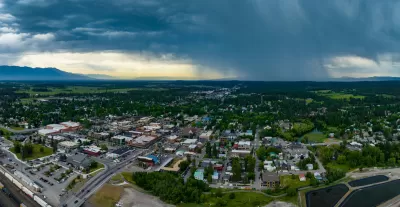The influx of new households to rural communities is driving up housing costs for existing residents and straining local infrastructure, sparking difficult conversations about future growth.

The rapid growth of rural areas sparked by the Covid-19 pandemic, the rise of remote work, and increasingly unaffordable urban housing costs is a continuing source of frustration for rural residents who see their cost of living rising and their small communities changing. Nazmul Ahasan and Gregory Korte describe the crisis in Bloomberg CityLab.
As the authors explain, “The rural population expanded 0.3%, or 241,300 people, in the two years through mid-2022, according to Bloomberg calculations using Census data and a US Department of Agriculture methodology.” In 2021, the population in non-metro areas outgrew urban populations for the first time in three decades.
“The trend is sparking resentment as house prices in the top 10 rural counties that have seen the biggest population increases surged more than 40% over the past three years. Schools are overloaded and the shift is even impacting farmland prices.” In some of the most extreme cases like Jackson County, Georgia, home prices rose by 50 percent in the first half of 2023 compared to 2020.
The growth brings mixed feelings as “the arrival of new residents presents a dilemma for local officials, who prize the economic benefits they bring but also have to contend with poor infrastructure to sustain the growth. Locals complain about poor traffic infrastructure, noise, overloaded schools and even homelessness.”
FULL STORY: Pandemic Population Boom in Rural Hotspots Sparks Resentment

Planetizen Federal Action Tracker
A weekly monitor of how Trump’s orders and actions are impacting planners and planning in America.

San Francisco's School District Spent $105M To Build Affordable Housing for Teachers — And That's Just the Beginning
SFUSD joins a growing list of school districts using their land holdings to address housing affordability challenges faced by their own employees.

The Tiny, Adorable $7,000 Car Turning Japan Onto EVs
The single seat Mibot charges from a regular plug as quickly as an iPad, and is about half the price of an average EV.

Seattle's Plan for Adopting Driverless Cars
Equity, safety, accessibility and affordability are front of mind as the city prepares for robotaxis and other autonomous vehicles.

As Trump Phases Out FEMA, Is It Time to Flee the Floodplains?
With less federal funding available for disaster relief efforts, the need to relocate at-risk communities is more urgent than ever.

With Protected Lanes, 460% More People Commute by Bike
For those needing more ammo, more data proving what we already knew is here.
Urban Design for Planners 1: Software Tools
This six-course series explores essential urban design concepts using open source software and equips planners with the tools they need to participate fully in the urban design process.
Planning for Universal Design
Learn the tools for implementing Universal Design in planning regulations.
Smith Gee Studio
City of Charlotte
City of Camden Redevelopment Agency
City of Astoria
Transportation Research & Education Center (TREC) at Portland State University
US High Speed Rail Association
City of Camden Redevelopment Agency
Municipality of Princeton (NJ)





























